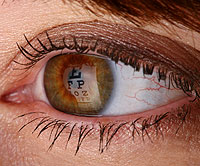Laser Vision Correction
 Laser vision correction refers to a group of minimally invasive procedures that reshape the cornea with laser energy to correct nearsightedness, farsightedness and astigmatism, leaving patients with 20/20 vision or better after treatment. These procedures are customized to provide the best possible results for each individual patient, allowing your surgeon to correct the very specific refractive errors that obscure your vision.
Laser vision correction refers to a group of minimally invasive procedures that reshape the cornea with laser energy to correct nearsightedness, farsightedness and astigmatism, leaving patients with 20/20 vision or better after treatment. These procedures are customized to provide the best possible results for each individual patient, allowing your surgeon to correct the very specific refractive errors that obscure your vision.
Laser vision correction procedures help patients eliminate the need for eyeglasses and contact lenses, a costly and bothersome hassle that millions of people deal with everyday. By reshaping the cornea, these procedures change the way that the eye focuses light, allowing you to enjoy clear vision.
There are several different laser vision correction procedures available to help patients achieve clear vision without glasses or contacts. Please call us today to schedule a consultation with one of our doctors to figure out which procedure is best for you.
LASIK
Laser-Assisted In Situ Keratomileusis (LASIK) is a safe, reliable and painless way to improve vision by changing the way light is bent, or refracted, as it passes through the cornea, so that it properly focuses on the retina and allows objects to be seen clearly.
During the LASIK procedure, the surgeon creates a thin flap in the surface of the cornea with a device called a microkeratome blade. This procedure is performed under local anesthesia so that pain is minimized. The corneal flap is then lifted and an excimer laser beam reshapes the cornea's curvature to improve vision. Finally, the flap is closed and covered with a protective contact lens. The entire procedure takes about 15 to 30 minutes per eye.
The ideal LASIK candidate includes someone who is over 18 years old, has stable vision and has a healthy cornea that is thick enough for a flap. After undergoing the procedure, patients experience immediate vision improvement and can often return to work the very next day.
IntraLase®
 IntraLase® has redefined the world of LASIK vision correction. Also known as blade-less LASIK, the IntraLase® all-laser procedure eliminates the need for a metal blade during surgery, helping bring clear vision to many people who feel uneasy about going "under the knife" during LASIK.
IntraLase® has redefined the world of LASIK vision correction. Also known as blade-less LASIK, the IntraLase® all-laser procedure eliminates the need for a metal blade during surgery, helping bring clear vision to many people who feel uneasy about going "under the knife" during LASIK.
The state-of-the-art IntraLase® technology replaces the microkeratome blade that has traditionally been used to cut the necessary corneal flap during laser vision correction procedures. Rather than creating the flap with a blade, IntraLase® uses laser energy to make a quick, painless incision. By replacing the hand-held blade with a computer-controlled laser, the risk of complications is virtually eliminated.
The Benefits of IntraLase®
Because of the low risk of complications and high level of precision it provides, blade-less LASIK treatment has become the standard of care among leading LASIK surgeons and ophthalmic teaching institutions worldwide.
Compared to methods that use a microkeratome blade, this minimally invasive and incredibly precise procedure decreases the occurrence of partial flaps, holes in the flap, and other traumatic flap complications. Of the more than 500,000 IntraLase® procedures that have been performed globally to date, there have been no reports of any serious or sight-threatening complications.
Z-LASIK
Z-LASIK is the latest advancement in laser refractive surgery. This safe procedure is used to correct vision issues including nearsightedness, farsightedness and astigmatism. The risk of complications with Z-LASIK is even lower than that of other forms of Lasik since it only uses the most precise laser and no scalpel, reducing the chance of developing dry eyes, poor night vision or haloes. In fact, Z-LASIK can provide the highest quality of vision improvement available today—even in those patients who were previously not eligible for laser surgery due to extreme myopia or thin corneas.
The difference between Z-LASIK and older LASIK techniques lies in the way the flap is created to reshape the cornea. Traditional methods employ a blade to make the flap incision, which is safe, but can produce a rough surface that may affect the vision. With Z-LASIK, the latest generation femtosecond laser is used to create a precisely customized, ultrathin flap accurately and with no pain experienced. This provides the patient with the best possible vision that can be achieved. Z-LASIK is also safer since the surgery only requires a few minutes per eye, keeping the time that the laser is applied to a minimum. Recovery time is shorter as well because this laser is gentler and does not produce inflammation of the eye tissue, enabling most patients to see clearly within hours after the procedure.
Photorefractive Keratectomy (PRK)
 Photorefractive keratectomy (PRK) uses an excimer laser to burn away a small amount (about 5 to 30 percent) of the top of the cornea. Instead of cutting a flap into the cornea with a blade, this method preserves the strength of the cornea and avoids the risk of perforation and other flap errors commonly associated with the blade method. During the PRK procedure, the surgeon also has greater control in the location and amount of tissue being removed, allowing patients to enjoy a much more accurate treatment.
Photorefractive keratectomy (PRK) uses an excimer laser to burn away a small amount (about 5 to 30 percent) of the top of the cornea. Instead of cutting a flap into the cornea with a blade, this method preserves the strength of the cornea and avoids the risk of perforation and other flap errors commonly associated with the blade method. During the PRK procedure, the surgeon also has greater control in the location and amount of tissue being removed, allowing patients to enjoy a much more accurate treatment.
The PRK method involves gently sculpting the cornea rather than cutting, allowing your surgeon to treat greater degrees of nearsightedness, as well as farsightedness and astigmatism. Up to 95 percent of patients with a correction of up to -6.00 diopters achieved vision of 20/40 or better after PRK, with up to 70 percent achieving 20/20.
Before LASIK was available, PRK was the most commonly performed refractive surgery procedure. LASIK brought about several advantages over PRK, including less discomfort and faster results, but PRK is still preferred for patients with large pupils or thin corneas. The PRK procedure takes less than a minute to complete, and is performed with only anesthetic eye drops.

